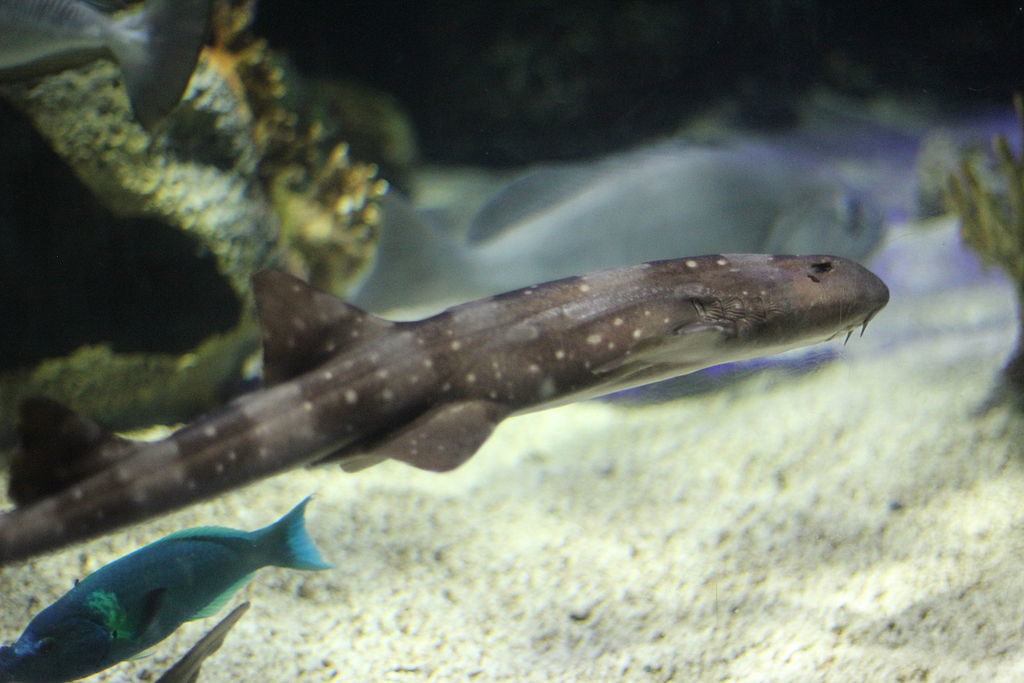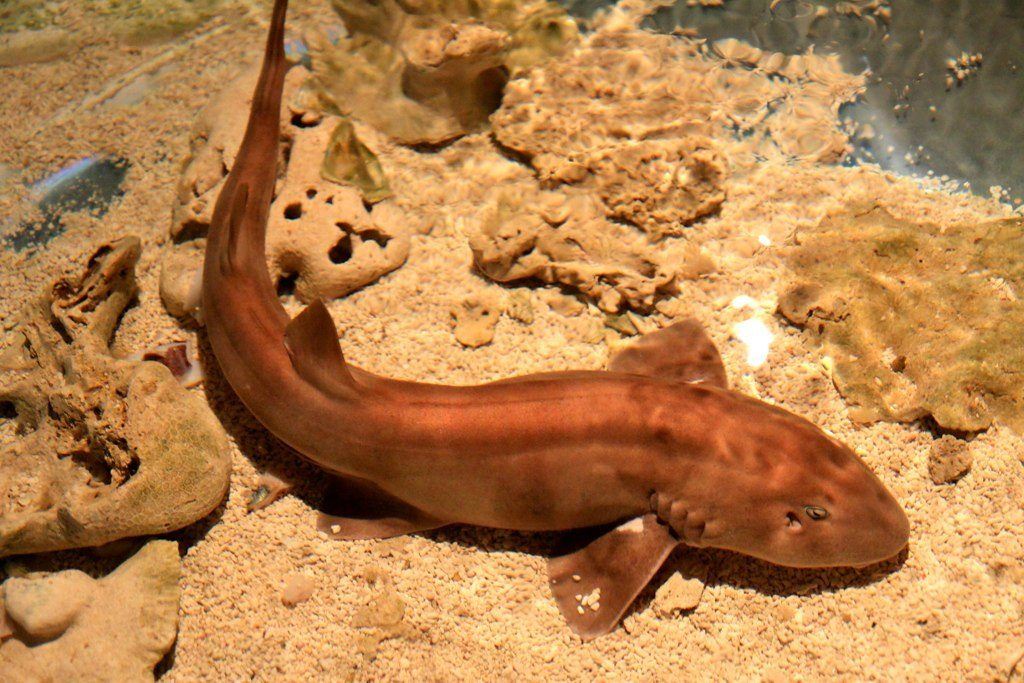Keeping aquariums can turn into something of an obsession.
There are so many possibilities in keeping aquatic animals, from saltwater to freshwater, open ocean tanks and reef tanks, and the more you understand about keeping your own little ecosystems, the more you may be ready for more challenges.

So, what about a shark? There are certainly options for keeping these top-tier predators in home tanks, though only certain species are small enough to make this possible.
Cat sharks are among them, but are you up for the challenge?
Let’s take a closer look at this unique little fish, and the challenges you may face in caring for it.
Contents
Basic Cat Shark Facts
There are over 160 species of cat sharks, but they are all ground sharks of the family scyliorhinidae.
While there are a few different species available for aquarists to purchase, we’ll be looking at the black banded cat shark (Chiloscyllium punctatum), also called the brown banded bamboo shark.
They are bottom feeders, and tend to feed on invertebrates and smaller fish. In the wild, they live primarily in the Indo-Pacific and Australia in reefs and tide pools, and like to hang out in sandy areas on the ocean floor.
Appearance and Size
Cat sharks get their name from the barbels around their mouth that look like cat whiskers! They have a cream-colored body separated by broad, dark stripes, and may have large pale brown spots as they grow older.
They can grow up to 40 inches long, though can be purchased in a variety of smaller sizes as younger fish, and can even be purchased as an egg to be reared completely in your home aquarium.
Cost
As is the case with many saltwater fish, especially predators, they can be an expensive addition, but you may pay less if you buy them as an egg.
While these sharks are harder to find in local pet stores, they are likely to be found in exotic fish stores or aquarium specialists, and many can be ordered online.

If you order online, be prepared to pay a very hefty shipping fee.
Due to their size, they need to be shipped in a good amount of water, which can make the package very heavy and may only be delivered by specialized carriers. They can certainly end up being an investment!
Cat Shark Care
Tank Requirements
These cool little sharks require a lot of space. Aside from the fact that they grow to a good size if, given space, they are very active and need plenty of room to turn their long bodies.
At a minimum, they should be in a 180-gallon tank, but preferably a tank of 360 gallons or more.
Since they can be aggressive eaters, it is not suggested that they be a part of a reef tank. They can also knock over reef or coral, and may even take a bite out of the live coral.
While some people have had success with these sharks in a reef tank, it takes a lot of work and a good bit of luck as well.
Sharks kept in reef tanks need to be kept extremely well-fed, otherwise, they are likely to snack on tankmates that are vital to the health of a reef tank.
Cat sharks need a sandy substrate that isn’t too coarse of a grain, as this could damage their sensitive underbellies.
A scratch on their belly could lead to infection and the eventual death of the fish. They also like plenty of places to hide and forage, as well as space to swim about.
They do better with tanks that have rounded corners instead of a traditional square aquarium, as this helps prevent them from bruising their noses when they turn.
Water Requirements
As with all fish tanks, the water, substrate, and decorations should be cycled in the tank before fish are introduced.

The pH level should be between 8.1 and 8.4, and pH can be tested with any home test kit. The specific gravity should be maintained between 1.020 to 1.025.
You can use pre-mixed saltwater, or mix your own at home, but as always make sure that the water has been thoroughly dechlorinated.
The temperature in the tank should stay between 72 and 78 degrees Fahrenheit. You may need to invest in a tank heater to keep this range.
Cat sharks do not need a strong light source, but the light should be able to reach the bottom of the tank to keep them on a consistent day/night schedule.
They are primarily nocturnal creatures, so for their health, it is best for the light to be kept on a cycle, rather than on at all times.
Tank Set-Up
If you already have fish in your tank and want to add a cat shark, the best way to do so is in a quarantine tank first.
This not only keeps a potentially sick fish away from the others, but it allows the new fish to get used to the water and food you are providing, reducing stress.
Before you remove your cat shark from quarantine, make sure that the tank has plenty of places for the shark to hide.
Rearrange the current layout of your tank to distract the existing fish and remove any established territories. Feed your current fish right before introducing the new one, which will make them less aggressive.
It is also better to introduce more than one new fish at once, as it reduces the chances of one new fish being singled out and aggravated.
And, as always, make sure your water is clean and appropriately balanced to reduce stress in all of the fish.
Don’t be concerned if your cat shark finds a place to hide and stays there for a while; they are naturally shy creatures and may take some time to acclimate to a new environment. The best way to lure them out is with food.

Tank Maintenance
Once a tank is set up and the sharks are happy, water changes are the best way to maintain a healthy tank.
Smaller tanks require more frequent water changes because toxins such as ammonia and nitrates build up more quickly compared to larger tanks.
Regular water changes and good filters are more important the smaller the tank. Once a week, take out the filter and clean it, and change the tank water at least once a month.
Replace 10-25% of the tank’s water each month, and make sure you check the temperature, specific gravity, and pH afterwards to maintain your healthy tank environment.
Be careful when cleaning the tank, as if startled these sharks can pack a nasty bite!
They are not venomous but are quite capable of using their teeth. If you are concerned, consider removing them to a quarantine tank while you clean the main tank to avoid possible conflict.
Feeding Cat Shark
Cat sharks are opportunistic carnivores, and will happily snack on smaller tankmates.
Keep them fed and happy on a variety of meaty foods like krill, shrimp, squid, small pieces of fish, scallops, clams, and mussels. With some patience and training, they may learn to eat sinking pellets.
Many people enjoy feeding them by hand, as these little fish have big personalities and will quickly recognize when it’s feeding time.
Feeding may be difficult in the beginning since they are shy, but offering small pieces of raw foods should entice them.
Feed once a day, or once every other day, as much as the shark will eat in one sitting.
Here’s a video showing how to feed a newborn bamboo cat shark.
Health Concerns
Disease can be introduced to the tank when you add anything that has not been properly cleaned or quarantined, including live rock, corals, and fish.
The best prevention is proper care and cleaning of anything new going into the tank, as well as making sure that you provide quality food, good water, proper tank mates, and that the pH and specific gravity of the water are maintained.
The more stressed a fish is, the more likely they are to get sick.
The biggest thing to be cautious of: If you need to introduce medication into the tank, make sure it does not contain copper.
Copper is lethal to cat sharks. If you have to use copper medication, either take the fish that needs the medicine into the quarantine tank to treat it.

Or if you need to treat the whole tank, remove the cat shark into quarantine and keep it there until the water has fully cycled.
Cat Shark Tankmates
Because cat sharks are such voracious eaters, they should not be put in a tank with anything that they would consider prey. This includes smaller fish and crustaceans, and other invertebrates.
Generally, if the other creature can fit inside the cat shark’s mouth, it will eat it. Try to avoid especially other ground-dwelling fish, as they will most likely be on the shark’s radar.
These fish do well with groupers, angelfish, tangs, lionfish, squirrelfish, butterflyfish, foxface fish, hawkfish, and eels.
Avoid putting them with fish that may nip at their fins and barbels, such as pufferfish or triggerfish. When in doubt, consult your local exotic fish specialist.
These hardy and interesting little sharks are popular with expert aquarium enthusiasts not only for their body shape and color, but their big personalities.
Many will come up to receive attention from their owners, and some even change their normally nocturnal behavior to pay attention to the activity within the house.
Being able to raise the cat shark from an egg can give you years of enjoyment from this aggressive little shark, but be sure you are able to take care of it in a large enough tank with appropriate tankmates.
Do you own a cat shark?

